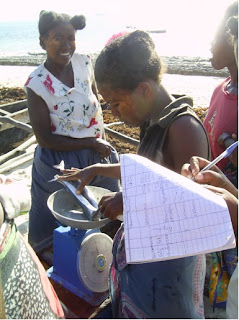 loating around the boat – such as my camera (in its underwater housing luckily) and the pirogue sailer’s shoes. Pirogues are such cool boats that even when completely full of water – which this one was at that point – they do not sink. Which is lucky really, as once Bic and the sailer had bailed us out, we were on our way once again.
loating around the boat – such as my camera (in its underwater housing luckily) and the pirogue sailer’s shoes. Pirogues are such cool boats that even when completely full of water – which this one was at that point – they do not sink. Which is lucky really, as once Bic and the sailer had bailed us out, we were on our way once again.We got to Lamboara at about 10 and were greeted on the beach by some singing children, who seemed particularly fascinated by Ellie, and accompanied us to the village President’s house. The village president greeted us, showed us the A3 hand-drawn maps of the mangroves that the village has been working on and invited us inside his house before it started raining. We were given some coffee and bok bok (fried doughy doughnut things) and waited for the women with the fin-fish data to arrive. When we’re in Andavadoaka, and comparing it with our towns, cities or villages from home, it’s easy to forget that it’s actually a relatively prosperous village compared to some of the other settlements along the coast. While Andavadoaka has a population of around 2,000, Lamboara has a population of just 600. While Andavadoaka has a number of tiny epi-bars, stalls and a supermarket selling everything the volunteer far from home could desire, Lamboara has none of this and instead children walk along singing the price of the bok bok that they are selling.
The women who collect data for our fin fish monitoring turned up and Bic showed me the books where they record the data. Every fortnight, the women go down to the beach to measure and weigh the fish brought in by the fisherman. They use fish identification books (the same kind as the volunteers here use) to identify the fish, and scales and tape measures bought by Blue Ventures. They also record additional data – such as the method of fishing (spear gun, fishing line etc.) name of the fisherman, and his age. I looked through the data of one book and found that the oldest fisherman on that day was 58, the youngest, 10. Bic then collects all the data, enters it back here on a computer and sends it back to London where it is analysed.
Following this, we met with the women’s association and Lalao introduced herself to them, as she will be working with them to help keep developing the small-scale crafts that they are making to sell. We met with them for a while, enjoyed lunch cooked by the president’s wife, and then after a brief walk around the village, it was time to head back. Thankfully our return trip was pretty uneventful. It was also quicker, due to a change in the wind direction and wind speed and it took us less than 90 minutes before we arrived back on half moon beach. I’d sat on the balancoire for the last twenty minutes and arrived breathless and excited from the journey. It was definitely good to see somewhere different, but it was good to be home again too.
Ruth Rosselson (Expedition Manager)

